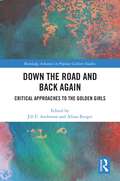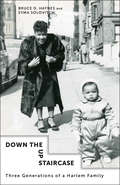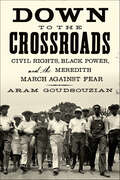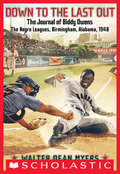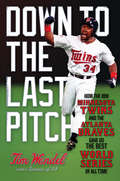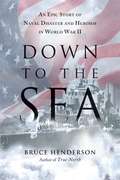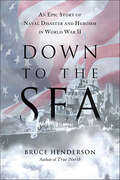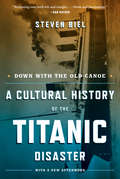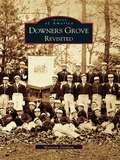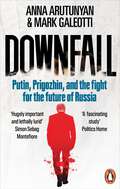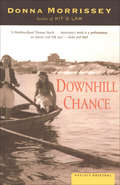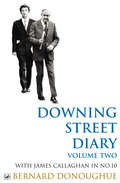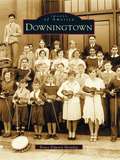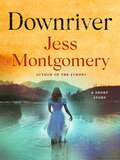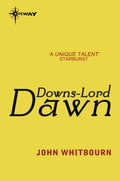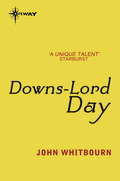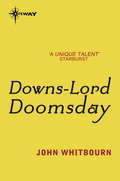- Table View
- List View
Down the Road and Back Again: Critical Approaches to The Golden Girls (Routledge Advances in Popular Culture Studies)
by Alissa Burger Jill E. AndersonThis is the first book‑length study of The Golden Girls, which ran for seven award‑winning seasons from 1985 to 1992 and produced two spin-offs.Through a cultural studies approach, this collection examines a wide range of topics, including race, sexuality, queerness, memory, familial mythmaking, aging, health, and financial precarity. Featuring contributions from an international team of scholars, this book highlights the enduring relevance and cultural impact of the show, even 30 years after its original airing.Offering fresh insights into its cross‑generational and cross‑cultural appeal, Down the Road and Back Again is intended for scholars of pop culture and fans of the show.
Down the Up Staircase: Three Generations of a Harlem Family
by Bruce Haynes Syma SolovitchDown the Up Staircase tells the story of one Harlem family across three generations, connecting its journey to the historical and social forces that transformed Harlem over the past century. Bruce D. Haynes and Syma Solovitch capture the tides of change that pushed blacks forward through the twentieth century—the Great Migration, the Harlem Renaissance, the early civil rights victories, the Black Power and Black Arts movements—as well as the many forces that ravaged black communities, including Haynes's own. As an authority on race and urban communities, Haynes brings unique sociological insights to the American mobility saga and the tenuous nature of status and success among the black middle class.In many ways, Haynes's family defied the odds. All four great-grandparents on his father's side owned land in the South as early as 1880. His grandfather, George Edmund Haynes, was the founder of the National Urban League and a protégé of eminent black sociologist W. E. B. Du Bois; his grandmother, Elizabeth Ross Haynes, was a noted children's author of the Harlem Renaissance and a prominent social scientist. Yet these early advances and gains provided little anchor to the succeeding generations. This story is told against the backdrop of a crumbling three-story brownstone in Sugar Hill that once hosted Harlem Renaissance elites and later became an embodiment of the family's rise and demise. Down the Up Staircase is a stirring portrait of this family, each generation walking a tightrope, one misstep from free fall.
Down to Earth Strafing Aces of the Eighth Air Force
by Chris Davey William Hess'Like The Long Reach, Down to Earth is a message from the battle at its height, told in their own words by the men who fight' - this is how Brig-Gen Francis Griswold, VIII Fighter Command, ends his introduction to this book. His official endorsement reveals just how important a document Down to Earth was to the teaching of tyro fighter pilots heading for action in the ETO. More leading aces were lost to flak whilst ground strafing than to German fighters. In this book William Hess has included biographies of all the pilots that originally contributed to this work back in 1943-44.
Down to the Bonny Glen (The Martha Years #3)
by Melissa WileyMartha is frustrated because Mum has said she's too old to be playing on the moors now, and she must have a governess. First there's Miss Norrie. All she wants to do is teach Martha sewing and etiquette. But Martha's high spirits are too much for her, and she leaves in a hurry. Martha thinks that's the end of that, but then another governess shows up. Her name is Miss Crow, and Martha is sure she's going to be even worse! Down To The Bonny Glen is the third book in The Martha Years, an ongoing series about another spirited girl from America's most beloved pioneer family. The Bookshare collection has the whole Martha series which includes: Little House in the Highlands, The far side of the Loch, and Beyond the Heather Hills.
Down to the Crossroads: Civil Rights, Black Power, and the Meredith March Against Fear
by Aram GoudsouzianIn 1962, James Meredith became a civil rights hero when he enrolled as the first African American student at the University of Mississippi. Four years later, he would make the news again when he reentered Mississippi, on foot. His plan was to walk from Memphis to Jackson, leading a "March Against Fear" that would promote black voter registration and defy the entrenched racism of the region. But on the march's second day, he was shot by a mysterious gunman, a moment captured in a harrowing and now iconic photograph. What followed was one of the central dramas of the civil rights era. With Meredith in the hospital, the leading figures of the civil rights movement flew to Mississippi to carry on his effort. They quickly found themselves confronting southern law enforcement officials, local activists, and one another. In the span of only three weeks, Martin Luther King, Jr., narrowly escaped a vicious mob attack; protesters were teargassed by state police; Lyndon Johnson refused to intervene; and the charismatic young activist Stokely Carmichael first led the chant that would define a new kind of civil rights movement: Black Power. Aram Goudsouzian's Down to the Crossroads is the story of the last great march of the King era, and the first great showdown of the turbulent years that followed. Depicting rural demonstrators' courage and the impassioned debates among movement leaders, Goudsouzian reveals the legacy of an event that would both integrate African Americans into the political system and inspire even bolder protests against it. Full of drama and contemporary resonances, this book is civil rights history at its best.
Down to the Last Out: The Negro Leagues, Birmingham, Alabama, 1948 (My Name is America)
by Walter Dean MyersNewbery and Coretta Scott King award-winning author Walter Dean Myers's baseball story THE JOURNAL OF BIDDY OWENS is now available in paperback, with an exciting repackaging!Seventeen-year-old Biddy Owens is part of the Birmingham Black Barons baseball team and dreams of becoming a major league baseball player. However, in 1948 most black players can only play for the Negro Leagues. Jackie Robinson has just recently integrated and is playing for the Brooklyn Dodgers, but the white owners are reluctant to add too many blacks to their rosters. The Birmingham Black Barons are some of the best players in the league. But as they travel around playing ball, Biddy realizes that not everyone is ready for blacks and whites to play on the same team. Can Biddy prove he's good enough to be part of the game his loves, no matter what color his skin is?
Down to the Last Pitch: How the 1991 Minnesota Twins and Atlanta Braves Gave Us the Best World Series of All Time
by Tim WendelNever in baseball history had a last place team rebounded to take the pennant the following season. Yet in 1991, lightning struck twice as the Minnesota Twins and the Atlanta Braves, a pair of cellar dwellers the year before, faced each other in an unforgettable World Series. For both clubs, the turnaround was one for the ages. Minnesota and Atlanta rallied throughout the 1991 season around a crop of rising stars--Kirby Puckett, Kent Hrbek, Tom Glavine, John Smoltz--who each spirited their team’s unlikely run all the way to the World Series. And what a Fall Classic it proved to be, with five of the seven games decided by a single run, four decided on the final pitch, and three--including game seven--ending in extra innings. When the final out was recorded, the cover headline in Baseball Weekly read: "Best World Series Ever. ” In Down to the Last Pitch, Tim Wendel delivers all the hopes, dreams, and drama in a season--and a Series--touched by magic.
Down to the Sea: An Epic Story of Naval Disaster and Heroism in World War II
by Bruce HendersonThis epic story opens at the hour the Greatest Generation went to war on December 7, 1941, and follows four U.S. Navy ships and their crews in the Pacific until their day of reckoning three years later with a far different enemy: a deadly typhoon.
Down to the Sea: An Epic Story of Naval Disaster and Heroism in World War II
by Bruce Henderson“World War II produced so many compelling stories that even students of that momentous conflict are apt to discover we’ve missed whole vital episodes. Down to the Sea, about a devastating 1944 Pacific typhoon that sank three destroyers and cost 756 American sailors their lives, is just such an eye-opener.” — New York PostFrom the New York Times bestselling author of Sons and Soldiers, an epic story opening at the hour the Greatest Generation went to war on December 7, 1941, and following four U.S. Navy ships and their crews in the Pacific until their day of reckoning three years later with a far different enemy: a deadly typhoon. In December 1944, while supporting General MacArthur’s invasion of the Philippines, Admiral William “Bull” Halsey neglected the Law of Storms—the unofficial bible of all seamen since the days of sail—placing the mighty U.S. Third Fleet in harm’s way. One of the most powerful fighting fleets ever assembled under any flag, the Third Fleet sailed directly into the largest storm the U.S. Navy had ever encountered—a maelstrom of 90-foot seas and 160-mph winds. More men were lost and ships sunk and damaged than in most combat engagements in the Pacific. The final toll: 3 ships sunk, 28 ships damaged, 146 aircraft destroyed, and 756 men lost at sea.In all, 92 survivors from the three sunken ships (each carrying a crew of about 300) were rescued, some after spending up to 80 hours in the water. Scores more had made it off their sinking ships only to perish in the monstrous seas; some from injuries and exhaustion, others snatched away by circling sharks before their horrified shipmates. In the farflung rescue operations Bruce Henderson finds some of the story’s truest heroes, exhibiting selflessness, courage, and even defiance. One badly damaged ship, whose Naval Reserve skipper disobeyed an admiral’s orders to abandon the search, singlehandedly saved 55 lives.Drawing on extensive interviews with nearly every living survivor and rescuer, many families of lost sailors, transcripts and other records from two naval courts of inquiry, ships’ logs and action reports, personal letters, and diaries, Bruce Henderson offers the most thorough and riveting account to date of one of the greatest naval dramas of World War II.
Down with Childhood: Pop Music and the Crisis of Innocence
by Paul RekretSometimes popular music registers our concerns and anxieties more lucidly than we realise. This is evident in the case of an ideal of childhood innocence in rapid decay in recent decades.So claims Down with Childhood, as it takes in psychedelia’s preoccupation with rebirth and inner-children, the fascination with juvenilia amidst an ebbing UK rave scene and dozens of nursery rhyme hip-hop choruses spawned by a hit Jay-Z tune.As it examines the often complex sets of meanings to which the occasional presence of children in pop songs attests, the book pauses at Musical Youth’s ‘Pass the Dutchie’ and other one-hit teen wonders, the career paths of child stars including Michael Jackson and Britney Spears, radical experiments in free jazz, and Black Panther influenced children’s soul groups.In the process, a novel argument begins to emerge relating the often remarked crisis of childhood to changing experiences of work and play and ultimately, to an ongoing capitalist crisis that underlies them.
Down with Colonialism!
by Ho Chi MinhThe legendary leader of Vietnam was not big on revolutionary theory, says Walden Bello, but he and fellow anti-imperialists today might learn from and be inspired by his portrayals of a committed revolutionary translating the concepts and ideas into strategy, tactics, and organization that would defeat two empires. He collects 49 speeches, essays, position statements, reports, and public letters.
Down with the Old Canoe: A Cultural History of the Titanic Disaster (Updated Edition)
by Steven Biel"Brimming over with wit and insight. . . . Fresh and fascinating."--Dan Rather Everyone from suffragists to their opponents; radicals, reformers, and capitalists; critics of technology and modern life; racists and xenophobes and champions of racial and ethnic equality; editorial writers and folk singers, preachers and poets found moral and cultural lessons in the sinking of the Titanic. In a new edition that both commemorates the one hundredth anniversary of the disaster and elaborates, in a revised afterword, on the ship's continued impact on the public imagination (evidenced by the Titanic mania evoked by James Cameron's 1997 film), Steven Biel explores the Titanic in all its complexity and contradictions.
Downeast Genius: From Earmuffs to Motor Cars Maine Inventors Who Changed the World
by Earl H. SmithWhat do donut holes, the Stanley Steamer, a machine gun, the Bean boot and a can opener have in common? All were invented by the feverish minds and ingenuity of Mainers in the aftermath of the Civil War. In addition to being blessed with good imaginations and an ever-expanding surplus of junk, Mainers also have long, hard winters to tinker and tool, plus an stick-to-itiveness to “get er done.” In this delightful, informative compendium of 53 of some the greatest inventors in Maine's history—and the world’s— and their amazing inventions, beloved author and state historian Earl Smith discovers the whys, whats, and where-to-fores that prompted the creation of so many essentials and entertainments we now take for granted (paper bag, anyone?). Birthed by necessity, vision, and that other mother of invention, the great state of Maine.
Downeast: Five Maine Girls and the Unseen Story of Rural America
by Gigi GeorgesBased on four years of reporting, “a heartfelt portrait of five teenage girls growing up in Maine’s remote and economically depressed Washington County” (Publishers Weekly).Downeast follows five girls as they come of age in one of the most challenging and geographically isolated regions on the Eastern seaboard. Nestled in Maine’s far northeast corner, Washington County sits an hour’s drive from the famed Acadia National Park. Yet it’s a world away. For Willow, Vivian, Mckenna, Audrey, and Josie—five teenagers caught between tradition and transformation in this remote region—it is home. Gigi Georges traces their journeys of heartbreak and hope in uncertain times, creating a nuanced portrait of rural America with women at its center.Willow lives in the shadow of an abusive, drug-addicted father and searches for stability through photography and love. Vivian, a gifted writer, feels stifled by her church and town, and struggles to break free without severing family ties. Mckenna is a softball pitching phenom whose passion is the lobster-fishing she learned at her father’s knee. Audrey is a beloved basketball star who earns a coveted college scholarship but questions her chosen path. Josie, a Yale-bound valedictorian, is determined to take the world by storm. All five know the pain and joy of life in a region whose rugged beauty and stoicism mask dwindling populations, vanishing job opportunities, and pervasive opioid addiction. As the girls reach adulthood, they discover that despite significant challenges, there is much to celebrate in “the valley of the overlooked.” Their stories remind us of the value of timeless ideals: strength of family and community, reverence for nature’s rule, dignity in cracked hands and muddied shoes, and the enduring power of home.“[A] remarkable book . . . important, arresting, and engrossing.”—Christina Baker Kline, #1 New York Times–bestselling author of Orphan Train
Downers Grove Revisited (Images of America)
by Montrew DunhamOn a May evening in 1832, a solitary 50-year-old man on horseback rode toward an oak grove that rose majestically from the quiet Illinois prairie. Stopping at this beautiful site, the man bent a sapling to mark his claim to the rich Illinois farmland that would be his for the settling. In that singular act, Pierce Downer founded the town that would bear his name: Downers Grove, Illinois.He could hardly have imagined the remarkable development of the bucolic prairie town, 22 miles west of Chicago, as it grew to a thriving suburb with a population of nearly 50,000. Many unique and influential people have shaped the history of Downers Grove.
Downfall of the Crusader Kingdom: The Battle of Hattin and the Loss of Jerusalem
by W B BartlettThe Third Crusade of Richard the Lionheart is well known but the build-up to it less so. Downfall of the Crusader Kingdom is a story of intrigue, plot and counter-plot, and the abuse of power culminating in the most decisive battle of the medieval epoch, the Battle of Hattin in 1187. Hattin is one of the few battles in history that can truly be called decisive, and it was a catastrophe for the Crusaders. The leading men of the kingdom of Jerusalem, including the Knights Templar and the Hospitallers, were trapped in an arid wasteland, without water and surrounded by hostile forces. The battle ended with thousands of them being taken prisoner. It was the culmination of a series of events that had been progressively leading the kingdom of Jerusalem down the road to oblivion. It was partly the resurgence of the Muslim Middle East and the rise of Saladin that led to the loss of Jerusalem, but there was another equally dangerous element at work - the enemy within. W B Bartlett brings to life the bitter infighting and political battles which ultimately led to the disaster at Hattin and the downfall of the Crusader kingdom.
Downfall: Putin, Prigozhin, and the fight for the future of Russia
by Mark Galeotti Anna ArutunyanIn the early years of Vladmir Putin’s Russia, Yevgeny Prigozhin emerged as one of the President’s most trusted assets. By 2023, he had become a dangerous warlord – and also one of Putin’s chief rivals in Russia’s tumultuous political climate, exiled after leading an attempted coup, and shortly after killed in a mysterious plane crash.But what is the truth about this enigmatic figure, his role in the war with Ukraine, and the chaos unleashed across Russia by his turn against Putin? And, in the aftermath of his death, what is next for Russia in the new stage of late Putinism that Prigozhin’s life forged?In a compelling tale that unravels a complex web of power, betrayal and recrimination, Downfall delves into the profound impact of Prigozhin on the heart and soul of a nation at a crossroads. Drawing on years of research, this book traces the rise of Russia's most prominent non-state actor and examines the political climate that propelled a convicted gangster with no government office to the formidable role he came to occupy. An essential story of Russia's recent history, Downfall is also a compelling insight into its likely future.
Downfall: The End of the Imperial Japanese Empire
by Richard B. FrankEnd of World War II in the East.
Downhill Chance: A Novel
by Donna Morrissey“[An] almost mythical story of fractured families, wars, and homecomings” from the international bestselling author of The Fortunate Brother (Quill & Quire).With Kit’s Law, Donna Morrissey established herself as a gifted storyteller. Her chronicle of life in a remote Newfoundland outport was acclaimed by critics and embraced by readers worldwide. Downhill Chance is a captivating successor to Morrissey’s first novel. Set in a pair of isolated fishing communities in Newfoundland during and after the Second World War, this is the story of two families joined by friendship but torn apart by fear and sorrows.Prude Osmond reads her tea leaves and predicts dark days ahead. Meanwhile, an hour’s boat ride away, Job Gale leaves his wife and two young daughters behind to fight in the war, a cause neither they nor their neighbors understand. The war and the dark secrets it holds cascade over the Gale family, afflicting the sensitive yet resourceful Clair, an unforgettable heroine. Forced to restart her life in another place, she must forsake the family she loves and her community.Morrissey blends drama, gritty realism, and a flair for the comic in this unique novel. At its core is the unravelling of secrets—and the redemption that truth ultimately brings.“Hardy and Dickens are the probable inspirations for this sprawling, old-fashioned tale of two maritime Newfoundland families . . . the narrative moves like a house afire, and its racy energy keeps our attention riveted.” —Kirkus Reviews“Achingly beautiful . . . A major novel by a remarkable writer.” —Booklist (starred review)
Downing Street Diary Volume Two: With James Callaghan in No. 10
by Bernard DonoughueThe first volume of Bernard Donoughue's Downing Street Diary was described by Charles Moore in the Daily Telegraph as 'the best account of Harold Wlson's last days'; 'the sheer scale and detail are fascinating' wrote Peter Riddell in the Times Literary Supplement. This second volume covers the three years, 1976-79, when Donoughue was Senior Policy Advisor to James Callaghan.At first Callaghan quickly established dominance over his cabinet and restored calm after the plots and scandals of the later Wilson years. His incomes policy reduced inflation and, in the teeth of opposition from the left wing, he negotiated the notorious IMF loan at the expense of eliminating some of Labour's most cherished dreams. By 1978, Callaghan, a politician of great patriotism and decency, seemed to have succeeded in steering Britain into calmer waters. But then the storm broke. Trade union militants brushed aside their mediocre leaders and launched a ferocious attack on Callaghan's pay policy, driving up inflation and demonstrating the government's impotence. In the diaries we see the prime minister and the government paralysed as the 'Winter of Discontent' began to bite and politics took to the streets.As Labour drifted to inevitable defeat in the 1979 election we see Callaghan fighting honourably. From the smoke of battle there emerges a striking new leader: Margaret Thatcher. The diaries describe vividly both the decline and final collapse of 'old' Labour and how Mrs Thatcher took the opportunity to launch her crusade to dismantle trade union power and much of the British public sector.Besides James Callaghan the chief figures in this volume of Lord Donoughue's diaries are Roy Jenkins, Denis Healey, Tony Crosland, Michael Foot, Shirley Williams, David Owen and Tony Benn.
Downingtown
by Bruce Edward MowdayFrom the days predating the American Revolution, Downingtown has played a vital part in the development of not only Chester County but also the commonwealth of Pennsylvania and the United States of America. It was an important stop for farmers and tradesmen transporting goods between Lancaster and Philadelphia. During the Philadelphia campaign of the Revolution in 1777, the Continental Congress approved the storage of material for George Washington's army in Downingtown. Situated in the heart of one of William Penn's three original counties of Pennsylvania, the area grew into an important manufacturing community, known for its paper mills fueled by the east branch of the Brandywine River, which flows through the middle of the town.
Downriver
by Jess MontgomeryDownriver is an evocative, gorgeously written short story: the tale of one woman's past—and her inability to escape it—from Jess Montgomery, author of the Kinship series."Now that I'm dying, I must decide what to do about the necklace."In 1939, many years ago, Rona Carter was a shy, lonely girl. Nothing like the pretty, popular Emily—the golden girl of Liberty, Ohio. Emily, whose body was found in the river.Now, the legend of Emily's death has lived on in Rona, in the town, and in the tiger's eye necklace that Emily’s mother gave her. Forced to reckon with her own mortality, Rona must decide whether to share a secret long kept buried—or take it to her grave.
Downs-Lord Dawn
by John WhitbournThomas Blades, a 17th century curate, discovers a magical door to another world - or rather to an alternative Earth. But here, humanity is not the top of the food chain, as Blades finds when the poor, burrow-dwelling humans he stumbles over are hunted and eaten by the Null - mighty, ravening beasts whose intelligence and killing ability makes them top predator.Returning to our own world for weapons, Blades vows to become humanity's saviour on his new earth and, over the years, builds an empire of which he becomes the first God-king. Power shifts between humanity and Null but as the humans grow in sophistication, so comes treachery, jealousy and murder - and God-king Blades will change much from the timid cleric who first happened upon his domain...
Downs-Lord Day
by John WhitbournThomas Blades has been released from his time as God-King in the alternative world he fought and ruled over. His descendants rule and fight but he cannot bear to return and meddle in their lives.
Downs-Lord Doomsday
by John WhitbournMeek and mild curate Thomas Blades discovered an alternative earth where humanity languished at the base of the food-chain. Over eventful years, Blades defeated the bestial Null master-race and carved out the empire of 'New-Wessex'. Shedding all former inhibitions, he ascended its throne as unchallenged 'god-king'. Exiled in turn by overpowering new enemies - the 'angels' - Blades was rescued by his own descendant, Guy Ambassador, after centuries of absence. Under Blades' strangely charmed leadership, the enigmatic and merciless angels were repulsed and humanity enjoyed a respite of liberty. But now, decades later, the venerable god-king broods in seclusion, refusing to die; the fountainhead of bitter thoughts and deeds. Meanwhile, Wessex sinks-into anarchy and neglect. Guy Ambassador travels amongst the bickering princedoms and warring states, wavering in the faith that has cost him family, friends and home. All around him the world of New-Wessex is moving towards resolution of its ultimate destiny and reason for being. Forces beyond human comprehension invade the already baroque realm.
